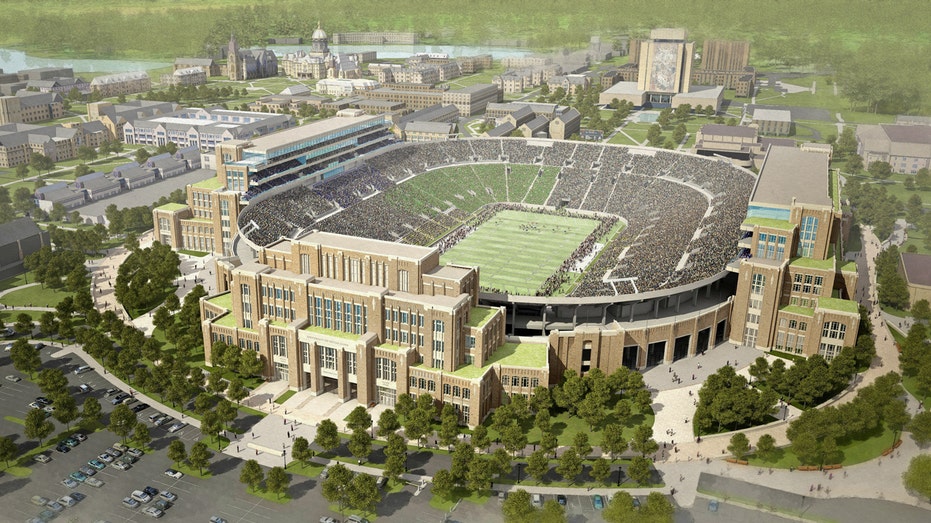Notre Dame Stadium's New Look Comes Into Focus

The University of Notre Dame’s iconic football stadium has received its first of many upgrades, just in time for the start of the 2016 season.
Fans will find upgraded seats, LED lighting and a new press box when the Fighting Irish taken on the University of Nevada in their home opener on Sept. 10. The renovations are part of a $400 million construction project that will bring a host of major changes to Notre Dame Stadium and the university’s campus.
Upon completion, the Campus Crossroads project will bring several additional improvements to the 86-year-old Notre Dame Stadium in 2017—most notably, new premium seats and the venue’s first-ever video board. The university is also constructing three buildings adjacent to the stadium, creating 750,000 square feet of academic offices, classrooms and hospitality space. The entire project remains on schedule for completion in August 2017, according to Notre Dame spokesman Dennis Brown.
Between 2,000 and 3,000 premium seats will extend from the top floors of the new academic buildings on the east and west sides of Notre Dame Stadium. Tickets will provide fans with access to brand new perks, such as all-inclusive food and beverages. The Club and Loge sections will be a first for Notre Dame, which has traditionally offered uniform seating with one set ticket price for each game.
Before the 2017 season, Notre Dame will install wider seats (from 16 to 18 inches) and remove one seat per row in order to create more room for fans. A new tunnel connecting the visiting locker room to the field is also in the blueprints. As a result, total capacity including the lower bowl, upper bowl and premium seats will drop to slightly below 80,000 seats, compared to the current tally of 80,795.

Notre Dame Stadium’s wood benches in the upper bowl have already been replaced by galvanized steel benches wrapped in blue vinyl. Bench seats in the lower bowl will be converted after the season.
The LED lights, which are more energy efficient and have longer life spans, provide more consistent lighting levels throughout the stadium. LEDs also improve color rendition during TV broadcasts.
The press box, which is mostly finished, has been moved to the top of Corbett Family Hall, a new academic and administrative building on the east side of Notre Dame Stadium. The Duncan Student Center sits on the west side, and the building to the south will be used by the university’s music department and sacred music program. All three buildings remain under construction.
By the start of the 2017 season, a 96-by-54-foot video board will adorn the south building’s stadium-facing wall. Notre Dame will put ribbon video boards along the face of the premium seating sections.
The addition of video boards and premium seating will enhance the gameday experience for fans, Brown said.
Other changes in the works include expanded cellular and WiFi service, new restrooms and renovated concession stands.
One of the objectives for Campus Crossroads was to turn Notre Dame Stadium, which is used 10 to 12 times each year, into a daily destination for everyone on campus.
“As the campus itself has expanded to the south, the stadium has become a place that has been the center of activity,” said Brown, Notre Dame’s assistant vice president for communications. “In a symbolic way, the Basilica of the Sacred Heart and the main building with the statue of Mary on the Golden Dome is at the heart of the university. In a geographic way, the stadium has become a crossroads for the campus itself.”
Approximately 750 construction workers are involved in the Campus Crossroads project, the most expensive undertaking in Notre Dame’s history.
The Fighting Irish, who posted a 10-3 overall record in 2015, are ranked No. 10 in the AP football poll to start the season. Notre Dame opens the 2016 campaign at the University of Texas on Sept. 4.



















